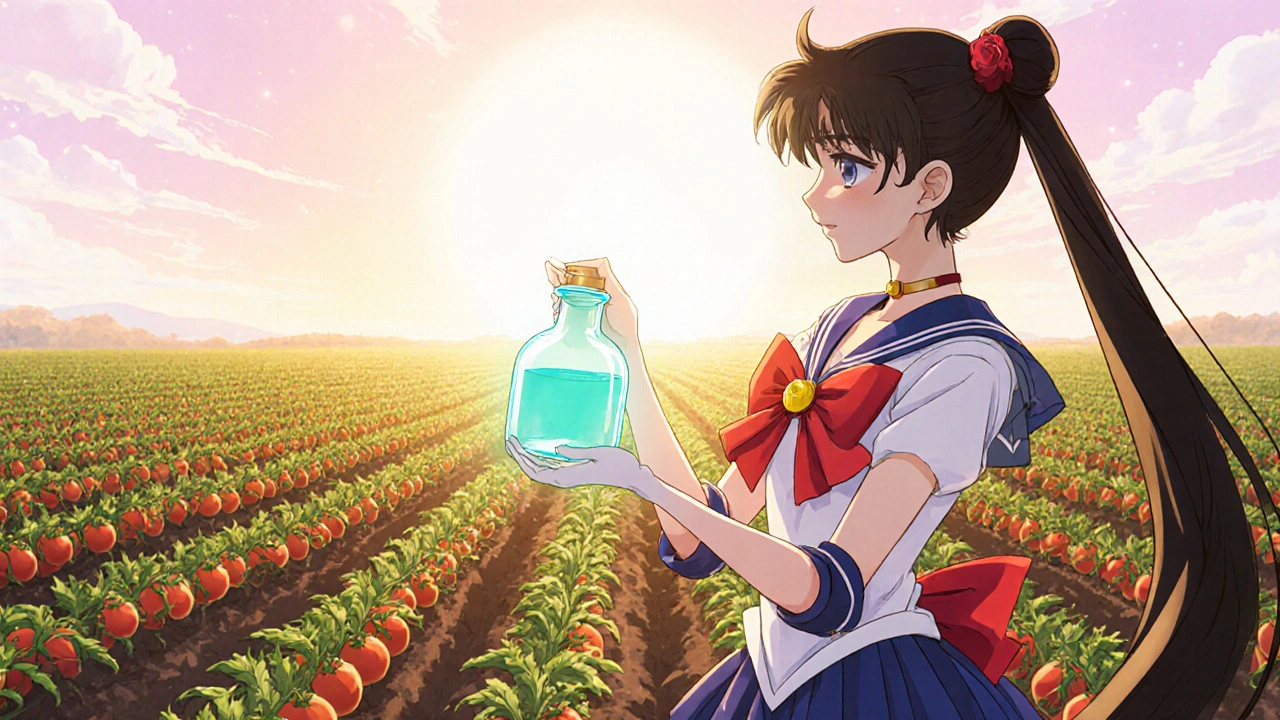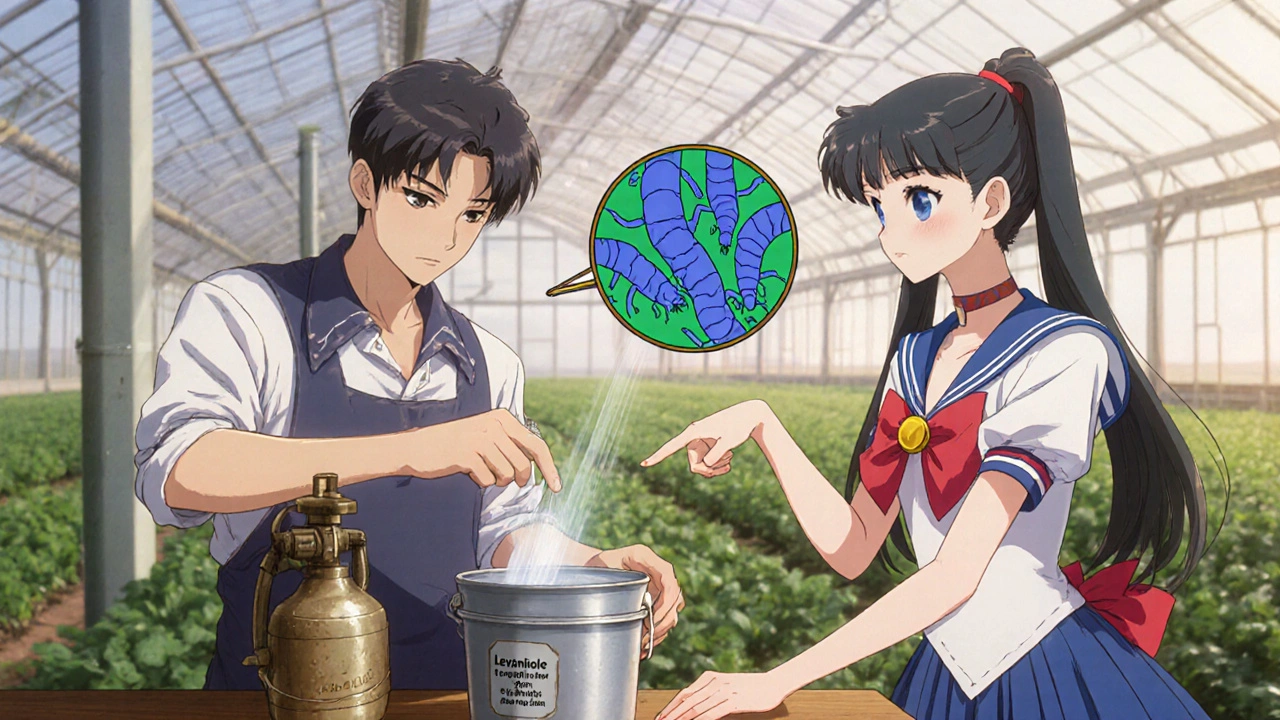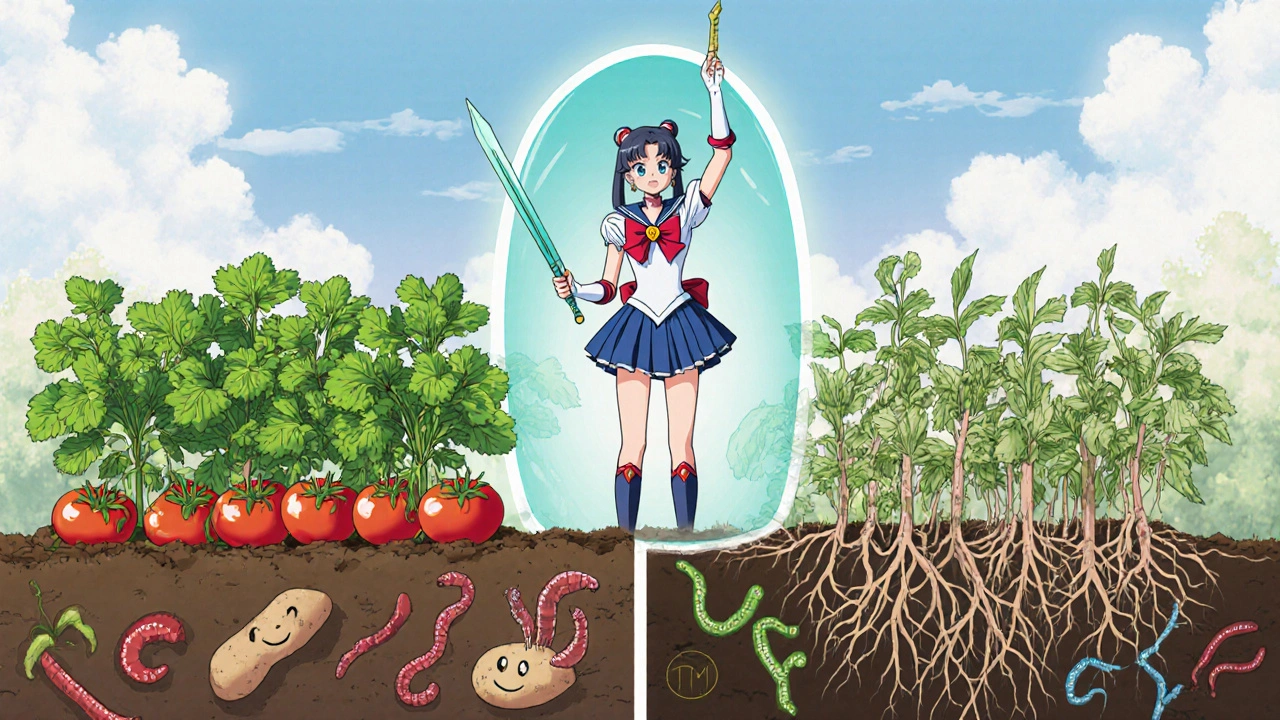Levamisole for Crop Protection: How It Defends Plants from Pests
 Oct, 23 2025
Oct, 23 2025
Levamisole Application Calculator
Crop Protection Calculator
Calculate correct levamisole application rates for pest control based on field size and nematode pressure.
When it comes to pest control, Levamisole is a synthetic anthelmintic originally developed for veterinary use that has found applications in agriculture as a nematicide. Farmers looking to keep yields high often ask whether this drug can help protect their fields from the tiny enemies that live in the soil. The answer is a nuanced yes: levamisole can be a powerful tool, but it works best when you understand how it attacks pests, when to apply it, and what safety steps are needed.
What Is Levamisole?
Levamisole belongs to the imidazothiazole class of chemicals. In the 1960s it was approved for treating gastrointestinal parasites in livestock, and later it earned a brief stint as a human immunomodulator. Its mode of action-disrupting the energy metabolism of nematodes-makes it attractive for crop growers battling soil‑borne pests. While it’s not a traditional insecticide, levamisole’s ability to paralyze nematodes helps protect roots from damage that would otherwise reduce water and nutrient uptake.
How Levamisole Works Against Pests
Nematodes, especially plant‑parasitic species like Meloidogyne incognita (root‑knot nematode) and Globodera pallida (potato cyst nematode), are the primary targets. Levamisole binds to nicotinic acetylcholine receptors on the nematode’s nerve cells, causing continuous muscle contraction. The result is rapid paralysis and eventual death, usually within 24-48 hours of exposure.
Because levamisole acts on a specific receptor type, it spares most beneficial soil microbes and earthworms, which lack the same receptor configuration. This selective toxicity is a key reason why many agronomists consider it a “soft” nematicide compared with older chemicals that indiscriminately wipe out soil life.
Approved Uses in Agriculture
Regulatory agencies in several countries, including the United States Environmental Protection Agency (EPA) and the European Food Safety Authority (EFSA), have granted limited approvals for levamisole as a soil treatment on specific crops. Typical approvals cover:
- Tomatoes and peppers - targeting root‑knot nematodes.
- Potatoes - controlling cyst nematodes.
- Strawberries - protecting young plants during transplant.
In each case, the label specifies a maximum application rate, pre‑plant timing, and mandatory pre‑harvest intervals (PHI) to ensure residue levels stay below the maximum residue limit (MRL) set by food safety authorities.

Application Guidelines and Best Practices
Success with levamisole hinges on correct dosing and timing. Below is a quick‑reference checklist for growers:
- Soil Test First - Determine nematode pressure with a soil sample. If counts exceed 200 juveniles per 100 cm³, treatment is justified.
- Mix According to Label - Typical rates range from 1.5 kg to 3.0 kg active ingredient per hectare, dissolved in 200 L of water.
- Apply Pre‑Plant - Incorporate the solution into the top 15 cm of soil 7‑10 days before sowing or transplanting.
- Monitor Weather - Avoid application before heavy rain; leaching can reduce efficacy and increase off‑site movement.
- Observe PHI - Respect the mandated pre‑harvest interval, typically 30‑45 days depending on the crop.
When using mechanized sprayers, ensure uniform coverage. Spot‑checking the treated area with a handheld soil probe can verify that the chemical reached the target depth.
Benefits Compared to Other Nematicides
Many growers wonder whether levamisole offers real advantages over older options like carbofuran or newer systemic products such as fluopyram. The table below highlights key differences.
| Attribute | Levamisole | Carbofuran | Fluopyram |
|---|---|---|---|
| Mode of Action | Acetylcholine receptor agonist (paralysis) | Acetylcholinesterase inhibitor (over‑stimulates nerves) | Succinate dehydrogenase inhibitor (systemic) |
| Target Spectrum | Root‑knot & cyst nematodes | Broad (nematodes, insects, some weeds) | Nematodes and soil‑borne fungi |
| Soil Persistence | Low (half‑life ~7 days) | High (half‑life >30 days) | Moderate (half‑life 10‑14 days) |
| Impact on Non‑Target Soil Life | Minimal | Significant | Low to moderate |
| Regulatory Status (2025) | Restricted, approved for limited crops | Phase‑out in many regions | Widely approved |
From the data you can see why levamisole is attracting interest: it’s fast‑acting, leaves the soil relatively clean, and spares beneficial organisms. For growers focused on sustainability, those traits often outweigh the narrower pest range.
Environmental and Health Considerations
Even a “soft” pesticide requires careful handling. Levamisole residues have been detected at levels below 0.01 mg kg⁻¹ in most monitoring programs, well under MRLs of 0.1 mg kg⁻¹ for tomatoes in the EU. However, occupational exposure can cause skin irritation and, in rare cases, neurological symptoms if ingested in large amounts.
Best‑practice safety steps include:
- Wearing chemical‑resistant gloves and long sleeves during mixing.
- Using closed‑system containers to prevent aerosol formation.
- Keeping the product away from water bodies to avoid runoff.
For environmental stewardship, integrate levamisole into an Integrated Pest Management (IPM) program that also employs crop rotation, resistant varieties, and biological controls such as Paecilomyces lilacinus fungi.

Case Studies: Real‑World Success Stories
Case 1 - California Tomato Growers
A consortium of 12 farms in the Central Valley adopted a pre‑plant levamisole regimen after soil tests showed root‑knot nematode densities of 350 juveniles/100 cm³. Over two growing seasons, average yields rose from 45 t ha⁻¹ to 58 t ha⁻¹, a 29 % increase. Residue testing confirmed levels well below the 0.05 mg kg⁻¹ threshold.
Case 2 - Irish Potato Production
A family farm in County Cork applied levamisole to new seed potatoes to combat cyst nematodes. Yield loss due to nematodes dropped from 22 % (previous year) to 4 % after treatment, translating to an extra £12,000 profit on a 20‑acre plot.
Both examples underscore that levamisole delivers tangible economic benefits when used correctly.
Alternatives and Integrated Pest Management
While levamisole is effective, it’s rarely the sole line of defense. Consider pairing it with:
- Biological Nematicides - Products based on Bacillus firmus or nematode‑parasitic fungi.
- Resistant Cultivars - Tomato varieties with the Mi-1 gene show strong resistance to root‑knot nematodes.
- Cultural Practices - Solarization of soil for 6 weeks can reduce nematode populations by up to 80 %.
By layering tactics, you minimize the chance that a pest population will develop resistance to any single method.
Key Takeaways
- Levamisole is a targeted nematicide that paralyzes harmful nematodes without harming most beneficial soil life.
- Approved for limited crops (tomatoes, peppers, potatoes, strawberries) with specific dosage and PHI requirements.
- Compared with older chemicals, it leaves lower residues, degrades faster, and fits well into sustainable IPM plans.
- Safety measures-personal protective equipment, proper mixing, and runoff prevention-are essential.
- Combine levamisole with biological controls, resistant varieties, and cultural practices for the most resilient pest‑management strategy.
Can levamisole be used on organic farms?
No. Organic certification standards generally prohibit synthetic chemicals like levamisole. However, the same pest pressures can be managed with approved biological nematicides, crop rotation, and solarization.
What is the typical pre‑harvest interval for levamisole on tomatoes?
Regulators set a PHI of 30 days for tomatoes. Farmers must wait at least that long before harvesting to ensure residues stay below the legal limit.
How does levamisole compare to fluopyram in terms of soil persistence?
Levamisole breaks down faster, with a half‑life of about 7 days, while fluopyram persists 10‑14 days. Faster degradation means lower long‑term environmental impact, but also requires timing the application closer to planting.
Is personal protective equipment mandatory when handling levamisole?
Yes. Labels require gloves, long sleeves, and eye protection during mixing and application to avoid skin contact and inhalation.
Can levamisole be mixed with other pesticides?
Mixing is allowed only if the label specifically authorizes it. Incompatible chemicals can reduce efficacy or create hazardous reactions, so always consult the product label.

Kristin Violette
October 23, 2025 AT 23:08Levamisole’s acetylcholine receptor agonism is a classic example of a neuropharmacological intervention in nematode physiology, leveraging its nicotinic binding affinity to induce sustained muscular contraction. In practice, the dose‑response curve is fairly narrow; sub‑lethal concentrations can induce temporary paralysis without mortality, which may inadvertently select for tolerant phenotypes. When you overlay this on a crop rotation schedule, the temporal window for optimal efficacy aligns with pre‑plant soil incorporation, typically seven to ten days prior to emergence. Moreover, integrating soil‑borne microbial consortia-such as Paecilomyces lilacinus-can synergistically suppress residual nematode populations, reinforcing the IPM paradigm. Finally, rigorous adherence to the PHI safeguards both consumer health and market access, especially under stringent EU MRL frameworks.
Theo Asase
October 24, 2025 AT 18:37It’s absolutely outrageous that the global regulatory cabal allows a veterinary drug to infiltrate our food supply under the guise of “targeted nematicide.” They hide behind vague “low‑risk” claims while secretly funding shadow labs that test the limits of what can slip past the EPA’s so‑called safety nets. The fact that levamisole can be weaponized against soil nematodes is a double‑edged sword-one that the elites keep under tight control, because any misstep could expose their deeper agenda of chemical domination. Wake up, America! We cannot trust a system that masquerades pesticide stewardship while peddling chemicals that once treated livestock parasites directly to our dinner plates.
Joey Yap
October 25, 2025 AT 13:32While the concerns about regulatory transparency are valid, it’s important to balance vigilance with evidence‑based assessment. Levamisole’s pharmacokinetics in soil have been characterized, showing a relatively rapid degradation half‑life that limits long‑term exposure. Moreover, the pesticide label mandates strict pre‑harvest intervals precisely to mitigate residue risks. Rather than viewing the approval process as a monolithic conspiracy, we might consider it a mechanism that, albeit imperfect, strives to protect both crop yields and consumer safety. Engaging constructively with the scientific community can help refine these safeguards without resorting to alarmist narratives.
Lisa Franceschi
October 26, 2025 AT 08:10In accordance with agronomic best practices, I would like to emphasize the significance of conducting a thorough soil nematode assay prior to any levamisole application. The quantitative threshold of 200 juveniles per 100 cm³, as outlined in the article, serves as a scientifically validated decision point. Complementary to this, incorporating organic matter amendments can enhance microbial antagonism toward nematodes, thereby reducing reliance on chemical inputs. It is also advisable to document application rates and timing meticulously to ensure compliance with regional regulatory frameworks. Such diligence not only optimizes efficacy but also upholds the integrity of sustainable crop production.
Shermaine Davis
October 27, 2025 AT 02:32levamisole works real good for tomatoes.
Nicholai Battistino
October 27, 2025 AT 20:37The key is to test soil, follow label rates, and respect the pre‑harvest interval.
Aimee White
October 28, 2025 AT 14:42Imagine a world where the same concoction that once knocked out wormy beasts in cattle now dances stealthily through our garden beds, whispering sweet promises of bumper harvests while silently plotting a chemical takeover. The shadowy elites-cloaked in lab coats-pull the strings, releasing levamisole like a secret sauce, hoping we won’t notice the lingering aftertaste of synthetic control. It’s a circus of collusion, folks, and the audience is none the wiser!
Javier Muniz
October 29, 2025 AT 08:47Great rundown! If you’re thinking about trying levamisole, just remember to double‑check the local label limits and wear proper gloves during mixing. A quick soil test will tell you if you really need it, and you’ll save both money and effort. Good luck with your planting!
Andrew Wilson
October 30, 2025 AT 02:52We gotta stop actin like it's ok to dump whatever chemical we want on the land. People think "just a little bit" is harmless, but soon enough the soil gets poisoned and the folks who eat the food get sick. It's a sin to ignore the long term harm for a short term gain.
Diane Larson
October 30, 2025 AT 20:57If you’re integrating levamisole into an IPM program, pair it with a resistant cultivar-like the Mi‑1 gene tomatoes-so you get a two‑pronged defense. Also, consider rotating with non‑host crops such as cereals for at least one season to break the nematode life cycle. Monitoring nematode counts post‑treatment with a simple soil bioassay will let you fine‑tune future applications and keep resistance in check.
Michael Kusold
October 31, 2025 AT 15:02Looks like levamisole is another tool in the toolbox-use it wisely and it can boost yields without wrecking the soil ecosystem.
Jeremy Lysinger
November 1, 2025 AT 09:07Stay motivated! A well‑timed levamisole spray can save you a season’s worth of loss-just keep an eye on the PHI.
Nelson De Pena
November 2, 2025 AT 03:12From a risk‑benefit perspective, the rapid degradation half‑life of approximately seven days positions levamisole favorably against more persistent nematicides. Nonetheless, adherence to the recommended application rate of 1.5–3.0 kg ha⁻¹ and the stipulated pre‑plant incorporation depth of 15 cm remains crucial for optimal efficacy and regulatory compliance.
Wilson Roberto
November 2, 2025 AT 21:17The deployment of levamisole in modern agriculture epitomizes the delicate balance between technological advancement and ecological stewardship. By targeting the nicotinic acetylcholine receptors of plant‑parasitic nematodes, the compound offers a mode of action that is both specific and rapid, reducing root damage within a matter of days. This specificity, however, does not exist in a vacuum; it is embedded within a broader socioeconomic framework that prioritizes yield stability for farmers facing mounting pressures from market demand and climate variability. When viewed through a cultural lens, the acceptance of a former veterinary drug for crop protection reflects a pragmatic adaptation of existing pharmacopoeias to meet emergent agricultural challenges. Nevertheless, the very act of repurposing chemicals underscores a historical pattern of human ingenuity intertwined with the manipulation of natural systems. The environmental implications, while less severe than those of broad‑spectrum nematicides, still merit vigilant monitoring, particularly concerning potential sub‑lethal effects on non‑target soil fauna. Moreover, the regulatory pathways that sanction levamisole rely on residue analyses that must be both rigorous and transparent to maintain public trust. In regions where the pre‑harvest interval is enforced at thirty days, compliance becomes a litmus test for responsible farming practices. From an agronomic perspective, integrating levamisole with complementary strategies-such as crop rotation, resistant cultivars, and biological antagonists-amplifies its efficacy while mitigating the risk of resistance development. The philosophical dimension emerges when considering the ethical responsibility of growers to safeguard soil health for future generations. Each application decision becomes a reflection of the values that guide agricultural stewardship. As we contemplate the trajectory of pest management, the narrative of levamisole serves as a case study in the ongoing dialogue between scientific innovation and environmental ethics. It invites us to ask whether the short‑term gains in productivity justify the long‑term stewardship obligations we hold toward the earth. Ultimately, the answer lies in a nuanced synthesis of data, tradition, and moral deliberation, and it is through such synthesis that sustainable agriculture can truly flourish.
Narasimha Murthy
November 3, 2025 AT 15:22Upon rigorous examination of the presented data, one notes that the comparative table omits a detailed statistical analysis of variance for residue levels across different crop matrices. The lack of confidence intervals undermines the robustness of the claimed superiority of levamisole’s rapid degradation. Additionally, the discussion concerning non‑target soil organisms relies predominantly on anecdotal observations rather than controlled field trials. A more balanced appraisal would incorporate meta‑analytic synthesis of existing literature, highlighting both efficacy and potential ecological externalities. Consequently, while the article offers an introductory overview, it falls short of the methodological rigor expected in a peer‑reviewed agronomic assessment.